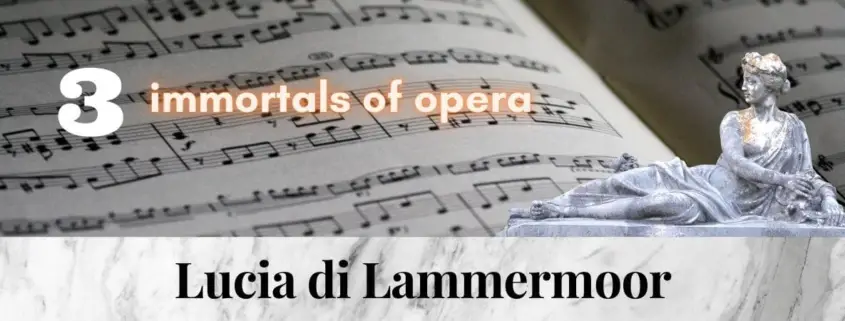3 immortal pieces from Donizetti’s LUCIA DI LAMMERMOOR – the best interpretations in YouTube
Lucia di Lammermoor is the love opera of the Bel Canto era and made Donizetti immortal. With the mad scene and the sextet, he influenced a generation of composers and, along with Rossini’s Barbiere di Siviglia and Bellini’s Norma, created the greatest monument of this period.
Regnava nel silenzio…Quando rapito in estasi – two famous arias
Lucia sings the legend of the fountain. This famous aria shows Lucia as a dreamy and thoughtful woman. The vocal lines are lyrical, yet brilliant in their ornamentation. Strings and winds enter in the piano and the heavy brass spread a somber mood. After two measures, the clarinet enters with an arpeggiated figure. This continually repeated figure reinforces the nocturne-like mood, and the soprano voice enters in piano above the arpeggiated figures. This arrangement allows the singer to expressively shape the melody of “Regnava nel silenzio.” Three trills in “si pria limpida” are particularly noteworthy. Lucia’s mood brightens with the subsequent cabaletta “Quando rapito in estasi”. Donizetti expresses the excitement about Edgardo’s imminent arrival with great leaps of tone, which present the singer with considerable difficulties. Donizetti also writes remarkable rubati in this aria. For example, time almost stands still in “Il ciel per me,” and then immediately returns to the basic tempo with “Si schiuda il ciel per me.” Also noteworthy is the trill in the middle of the aria, which extends over two measures. This first part is repeated again. For the ending, Donizetti chose an artful twist: the second-to-last “Ciel” ends on a C, and with a beautiful figure he repeats once again “Si schiuda il ciel” which ends on a spectacular D.
Maria Callas made stage history with the role of Lucia. The famous producer Walter Legge wanted to set new recording standards with the Scala ensemble and Serafin, and chose “Lucia di Lammermoor” among others. Kesting (“The Great Voices”): “The recording of Lucia was not yet finished when Legge sent the last three minutes of Act II on a tape snippet to Karajan. He immediately decided to stage the work himself, and he soon traveled to Berlin and Vienna with the performance. Callas as Lucia caused pandemonium in both opera houses, and it was not least this success that determined Vienna to appoint Herbert von Karajan as successor to the retired Karl Böhm at the State Opera.”
Hear Maria Callas in a magnificent and haunting interpretation of this aria in this recording conducted by Tullio Serafin.
Regnava nel silenzio…Quando rapito in estasi – Callas/Serafin
The famous quartet “Chi mi frena a tal momento”
Literature lovers may know the passage of Flaubert’s “Madame Bovary” in which Emma Bovary visits the Rouen Opera with her boring husband and the writer writes about the sextet with the thoughts of his protagonists. In a slow-motion moment (called a “concertato”), the main characters in this sextet sing their pain, anger and confusion off their souls. Musically, Donizetti has resolved this moment in an interesting way. The sextet begins with the two arch-enemies singing in harmony. The whole sextet is in major key, it is the calm before the storm. Commenting on this famous passage, Giacomo Puccini said that in one respect the Italians surpass the German composers, namely in the ability to express infinite sadness in the major key.
In the history of opera, the importance of this piece should not be underestimated; it became the model for an entire generation. The sextet, on a par with the “Rigoletto” quartet, represents one of the unsurpassed high points of Romantic ensemble culture.
In 1908, tenor Enrico Caruso and five singers made a recording of this sextet that became a legend – both for the musical artistry and the exorbitant retail price of the recording. It was sold on a one-sided record at a price of $7, earning it a nickname it has carried ever since: the “Seven-Dollar Sextet.” This equates to a retail price with today’s purchasing power of about $170.
Chi mi frena a tal momento – Caruso et al.
Lucia’s Mad Aria
This famous aria is a highly virtuosic piece. The so-called mad scene does not consist of an aria, but is a labyrinth of pieces which begins with an Andante, then leads into a manic Allegro vivace, is followed by a Recitativo Accompagnato followed by a Larghetto aria (with chorus) and an Allegro trio with Enrico, Raimondo and full chorus, and ends in another aria plus coda. No wonder this scene is considered one of the most difficult in operatic literature. Moreover, rapid leaps of tone between high and low vocal registers and virtuosic ornamentation demand a virtuoso coloratura technique. Donizetti wrote this aria with an accompaniment originally with a glass harmonica and added a version for flute. Nowadays, the famous passage is usually sung with the accompaniment of the coloratura sequence with the flute.
This mad cadenza became the most famous passage of this opera and is faithfully reproduced by most sopranos to this day. Listen to the famous Joan Sutherland singing the madness aria (and Nellie Melba’s famous cadenza just before 9:00).
Sutherland’s voice “is the happy combination of the fullness of a dramatic soprano voice with the treble assurance and coloratura fluency of a ‘soprano d’agilità’.” (Fischer, “Great Voices”). The great heights, however, were not God-given; she had to work for them; at the beginning of her training she was still considered a mezzo-soprano. Her husband, the pianist and conductor Richard Bonynge recognized that she had the potential and “unlike her, he had absolute pitch, and so he was able to deceive her by driving her voice up, claiming that she sang a third lower than she actually did; thus she accomplished things in private work that she would not have dared to do in public.” (Fischer, “Great Voices”).
Il dolce suono riso – Sutherland







Leave a Reply
Want to join the discussion?Feel free to contribute!